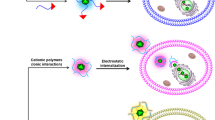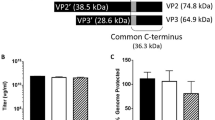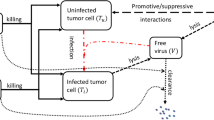Abstract
Conditionally replicating adenoviruses (CRAds) that replicate in tumor but less in normal cells are promising anticancer agents. A major determinant of their potency is their capacity for infecting target cells. The primary receptor for serotype 5 adenovirus (Ad5), the most widely used serotype in gene therapy, is the coxsackie-adenovirus receptor (CAR). CAR is expressed variably and often at low levels in various tumor types including advanced breast cancer. We generated a novel p16/retinoblastoma pathway-dependent CRAd, Ad5.pK7-Δ24, with a polylysine motif in the fiber C-terminus, enabling CAR-independent binding to heparan sulfate proteoglycans (HSPG). Ad5.pK7-Δ24 mediated effective oncolysis of all breast cancer cell lines tested. Further, we utilized noninvasive, fluorescent imaging for analysis of antitumor efficacy in an orthotopic model of advanced hormone refractory breast cancer. A therapeutic benefit was seen following both intratumoral and intravenous delivery. Murine biodistribution similar to Ad5, proven safe in trials, suggests feasibility of clinical safety testing. Interestingly, upregulation of CAR was seen in low-CAR M4A4-LM3 breast cancer cells in vivo, which resulted in better than expected efficacy also with an isogenic CRAd with an unmodified capsid. These results suggest utility of Ad5.pK7-Δ24 and the orthotopic model for further translational studies.
This is a preview of subscription content, access via your institution
Access options
Subscribe to this journal
Receive 12 print issues and online access
$259.00 per year
only $21.58 per issue
Buy this article
- Purchase on Springer Link
- Instant access to full article PDF
Prices may be subject to local taxes which are calculated during checkout






Similar content being viewed by others
References
Bernard-Marty C, Cardoso F, Piccart MJ . Facts and controversies in systemic treatment of metastatic breast cancer. Oncologist 2004; 9: 617–632.
Hemminki A, Alvarez RD . Adenoviruses in oncology: a viable option? Biodrugs 2002; 16: 77–87.
Immonen A, Vapalahti M, Tyynela K, Hurskainen H, Sandmair A, Vanninen R et al. AdvHSV-tk gene therapy with intravenous ganciclovir improves survival in human malignant glioma: a randomised, controlled study. Mol Ther 2004; 10: 967–972.
Peng Z, Han D, Zhang S, Pan J, Tang P, Xiao S et al. Clinical evaluation of safety and efficacy of intratumoral administration of a recombinant adenoviral-p53 anticancer agent (Genkaxin®). Mol Ther 2003; 7 (Suppl. 2): 422 (Abstract 1096).
Xia ZJ, Chang JH, Zhang L, Jiang WQ, Quan ZZ, Liu JW et al. Phase III randomized clinical trial of intratumoral injection of E1B gene-deleted adenovirus (H101) combined with cisplatin-based chemotherapy in treating squamous cell cancer of head and neck or esophagus. Ai Zheng 2004; 23: 1666–1670.
Kanerva A, Hemminki A . Modified adenoviruses for cancer gene therapy. Int J Cancer 2004; 110: 475–480.
Alemany R, Balague C, Curiel DT . Replicative adenoviruses for cancer therapy. Nat Biotechnol 2000; 18: 723–727.
Fueyo J, Gomez-Manzano C, Alemany R, Lee PS, McDonnell TJ, Mitlianga P et al. A mutant oncolytic adenovirus targeting the rb pathway produces anti-glioma effect in vivo. Oncogene 2000; 19: 2–12.
Heise C, Hermiston T, Johnson L, Brooks G, Sampson-Johannes A, Williams A et al. An adenovirus E1A mutant that demonstrates potent and selective systemic anti-tumoral efficacy. Nat Med 2000; 6: 1134–1139.
Helt AM, Galloway DA . Mechanisms by which DNA tumor virus oncoproteins target the rb family of pocket proteins. Carcinogenesis 2003; 24: 159–169.
Sherr CJ . Cancer cell cycles. Science 1996; 274: 1672–1677.
Anderson JJ, Tiniakos DG, McIntosh GG, Autzen P, Henry JA, Thomas MD et al. Retinoblastoma protein in human breast carcinoma: immunohistochemical study using a new monoclonal antibody effective on routinely processed tissues. J Pathol 1996; 180: 65–70.
Barker DD, Berk AJ . Adenovirus proteins from both E1B reading frames are required for transformation of rodent cells by viral infection and DNA transfection. Virology 1987; 156: 107–121.
Bauerschmitz GJ, Barker SD, Hemminki A . Adenoviral gene therapy for cancer: from vectors to targeted and replication competent agents (review). Int J Oncol 2002; 21: 1161–1174.
Lucas A, Kremer EJ, Hemmi S, Luis J, Vignon F, Lazennec G et al. Comparative transductions of breast cancer cells by three DNA viruses. Biochem Biophys Res Commun 2003; 309: 1011–1016.
Shayakhmetov DM, Li ZY, Ni S, Lieber A . Targeting of adenovirus vectors to tumor cells does not enable efficient transduction of breast cancer metastases. Cancer Res 2002; 62: 1063–1068.
Douglas JT, Kim M, Sumerel LA, Carey DE, Curiel DT . Efficient oncolysis by a replicating adenovirus (ad) in vivo is critically dependent on tumor expression of primary ad receptors. Cancer Res 2001; 61: 813–817.
Hemminki A, Dmitriev I, Liu B, Desmond RA, Alemany R, Curiel DT . Targeting oncolytic adenoviral agents to the epidermal growth factor pathway with a secretory fusion molecule. Cancer Res 2001; 61: 6377–6381.
Glasgow JN, Bauerschmitz GJ, Curiel DT, Hemminki A . Transductional and transcriptional targeting of adenovirus for clinical applications. Curr Gene Ther 2004; 4: 1–14.
Wickham TJ, Tzeng E, Shears LL, Roelwink PW, Li Y, Lee GM et al. Increased in vitro and in vivo gene transfer by adenovirus vectors containing chimeric fiber proteins. J Virol 1997; 71: 8221–8229.
Hemminki A, Belousova N, Zinn KR, Liu B, Wang M, Chaudhuri TR et al. An adenovirus with enhanced infectivity mediates molecular chemotherapy of ovarian cancer cells and allows imaging of gene expression. Mol Ther 2001; 4: 223–231.
Kanerva A, Mikheeva GV, Krasnykh V, Coolidge CJ, Lam JT, Mahasreshti PJ et al. Targeting adenovirus to the serotype 3 receptor increases gene transfer efficiency to ovarian cancer cells. Clin Cancer Res 2002; 8: 275–280.
Kanerva A, Zinn KR, Chaudhuri TR, Lam JT, Suzuki K, Uil TG et al. Enhanced therapeutic efficacy for ovarian cancer with a serotype 3 receptor-targeted oncolytic adenovirus. Mol Ther 2003; 8: 449–458.
Bernt KM, Ni S, Gaggar A, Li ZY, Shayakhmetov DM, Lieber A . The effect of sequestration by nontarget tissues on anti-tumor efficacy of systemically applied, conditionally replicating adenovirus vectors. Mol Ther 2003; 8: 746–755.
Sharma B, Handler M, Eichstetter I, Whitelock JM, Nugent MA, Iozzo RV . Antisense targeting of perlecan blocks tumor growth and angiogenesis in vivo. J Clin Invest 1998; 102: 1599–1608.
Matsuda K, Maruyama H, Guo F, Kleeff J, Itakura J, Matsumoto Y et al. Glypican-1 is overexpressed in human breast cancer and modulates the mitogenic effects of multiple heparin-binding growth factors in breast cancer cells. Cancer Res 2001; 61: 5562–5569.
Barbareschi M, Maisonneuve P, Aldovini D, Cangi MG, Pecciarini L, Angelo Mauri F et al. High syndecan-1 expression in breast carcinoma is related to an aggressive phenotype and to poorer prognosis. Cancer 2003; 98: 474–483.
Burbach BJ, Friedl A, Mundhenke C, Rapraeger AC . Syndecan-1 accumulates in lysosomes of poorly differentiated breast carcinoma cells. Matrix Biol 2003; 22: 163–177.
Burbach BJ, Ji Y, Rapraeger AC . Syndecan-1 ectodomain regulates matrix-dependent signaling in human breast carcinoma cells. Exp Cell Res 2004; 300: 234–247.
Goodison S, Viars C, Urquidi V . Molecular cytogenetic analysis of a human breast metastasis model: identification of phenotype-specific chromosomal rearrangements. Cancer Genet Cytogenet 2005; 156: 37–48.
Kirn D . Clinical research results with dl1520 (onyx-015), a replication-selective adenovirus for the treatment of cancer: what have we learned? Gene Therapy 2001; 8: 89–98.
Dechecchi MC, Melotti P, Bonizzato A, Santacatterina M, Chilosi M, Cabrini G . Heparan sulfate glycosaminoglycans are receptors sufficient to mediate the initial binding of adenovirus types 2 and 5. J Virol 2001; 75: 8772–8780.
Shinoura N, Yoshida Y, Tsunoda R, Ohashi M, Zhang W, Asai A et al. Highly augmented cytopathic effect of a fiber-mutant E1B-defective adenovirus for gene therapy of gliomas. Cancer Res 1999; 59: 3411–3416.
Weissleder R, Mahmood U . Molecular imaging. Radiology 2001; 219: 316–333.
Kanerva A, Wang M, Bauerschmitz GJ, Lam JT, Desmond RA, Bhoola SM et al. Gene transfer to ovarian cancer versus normal tissues with fiber-modified adenoviruses. Mol Ther 2002; 5: 695–704.
Bauerschmitz GJ, Lam JT, Kanerva A, Suzuki K, Nettelbeck DM, Dmitriev I et al. Treatment of ovarian cancer with a tropism modified oncolytic adenovirus. Cancer Res 2002; 62: 1266–1270.
Hemminki A, Zinn KR, Liu B, Chaudhuri TR, Desmond RA, Rogers BE et al. In vivo molecular chemotherapy and noninvasive imaging with an infectivity-enhanced adenovirus. J Natl Cancer Inst 2002; 94: 741–749.
Lam JT, Bauerschmitz GJ, Kanerva A, Barker SD, Straughn JM, Wang JM et al. Replication of an integrin targeted conditionally replicating adenovirus on primary ovarian cancer spheroids. Cancer Gene Ther 2003; 10: 377–387.
Lam JT, Kanerva A, Bauerschmitz GJ, Takayama K, Suzuki K, Yamamoto M et al. Inter-patient variation in efficacy of five oncolytic adenovirus candidates for ovarian cancer therapy. J Gene Med 2004; 6: 1333–1342.
Lamfers ML, Hemminki A . Multicellular tumor spheroids in gene therapy and oncolytic virus therapy. Curr Opin Mol Ther 2004; 6: 403–411.
Anders M, Hansen R, Ding RX, Rauen KA, Bissell MJ, Korn WM . Disruption of 3D tissue integrity facilitates adenovirus infection by deregulating the coxsackievirus and adenovirus receptor. Proc Natl Acad Sci USA 2003; 100: 1943–1948.
Fuxe J, Liu L, Malin S, Philipson L, Collins VP, Pettersson RF . Expression of the coxsackie and adenovirus receptor in human astrocytic tumors and xenografts. Int J Cancer 2003; 103: 723–729.
Qin M, Escuadro B, Dohadwala M, Sharma S, Batra RK . A novel role for the coxsackie adenovirus receptor in mediating tumor formation by lung cancer cells. Cancer Res 2004; 64: 6377–6380.
Wang M, Hemminki A, Siegal GP, Barnes MN, Dmitriev I, Krasnykh V et al. Adenoviruses with an RGD-4C modification of the fiber knob elicit a neutralizing antibody response but continue to allow enhanced gene delivery. Gynecol Oncol 2005; 96: 341–348.
Blackhall FH, Merry CL, Davies EJ, Jayson GC . Heparan sulfate proteoglycans and cancer. Br J Cancer 2001; 85: 1094–1098.
Sasisekharan R, Shriver Z, Venkataraman G, Narayanasami U . Roles of heparan sulphate glycosaminoglycans in cancer. Nat Rev Cancer 2002; 2: 521–528.
Wu H, Seki T, Dmitriev I, Uil T, Kashentseva E, Han T et al. Double modification of adenovirus fiber with RGD and polylysine motifs improves coxsackievirus-adenovirus receptor-independent gene transfer efficiency. Hum Gene Ther 2002; 13: 1647–1653.
Suzuki K, Alemany R, Yamamoto M, Curiel DT . The presence of the adenovirus E3 region improves the oncolytic potency of conditionally replicative adenoviruses. Clin Cancer Res 2002; 8: 3348–3359.
Krasnykh V, Belousova N, Korokhov N, Mikheeva G, Curiel DT . Genetic targeting of an adenovirus vector via replacement of the fiber protein with the phage T4 fibritin. J Virol 2001; 75: 4176–4183.
Acknowledgements
This study was supported by HUCH Research Funds (EVO), Academy of Finland, Emil Aaltonen Foundation, Finnish Cancer Society, University of Helsinki, Sigrid Juselius Foundation, Helsinki Biomedical Graduate School, EU FP6 THERADPOX, Sohlberg Foundation, Biocentrum Helsinki, Instrumentarium Research Fund, Research and Science Foundation Farmos, the Finnish Breast Cancer Group and the Finnish Oncology Association.
Author information
Authors and Affiliations
Corresponding author
Rights and permissions
About this article
Cite this article
Ranki, T., Kanerva, A., Ristimäki, A. et al. A heparan sulfate-targeted conditionally replicative adenovirus, Ad5.pk7-Δ24, for the treatment of advanced breast cancer. Gene Ther 14, 58–67 (2007). https://doi.org/10.1038/sj.gt.3302830
Received:
Revised:
Accepted:
Published:
Issue Date:
DOI: https://doi.org/10.1038/sj.gt.3302830
Keywords
This article is cited by
-
Evaluation of adenovirus capsid labeling versus transgene expression
Virology Journal (2010)
-
Ad5/3-9HIF-Δ24-VEGFR-1-Ig, an infectivity enhanced, dual-targeted and antiangiogenic oncolytic adenovirus for kidney cancer treatment
Gene Therapy (2009)
-
New Insights on Adenovirus as Vaccine Vectors
Molecular Therapy (2009)
-
Oncolytic virus therapy for pancreatic cancer using the adenovirus library displaying random peptides on the fiber knob
Gene Therapy (2009)
-
Luciferase imaging for evaluation of oncolytic adenovirus replication in vivo
Gene Therapy (2007)



